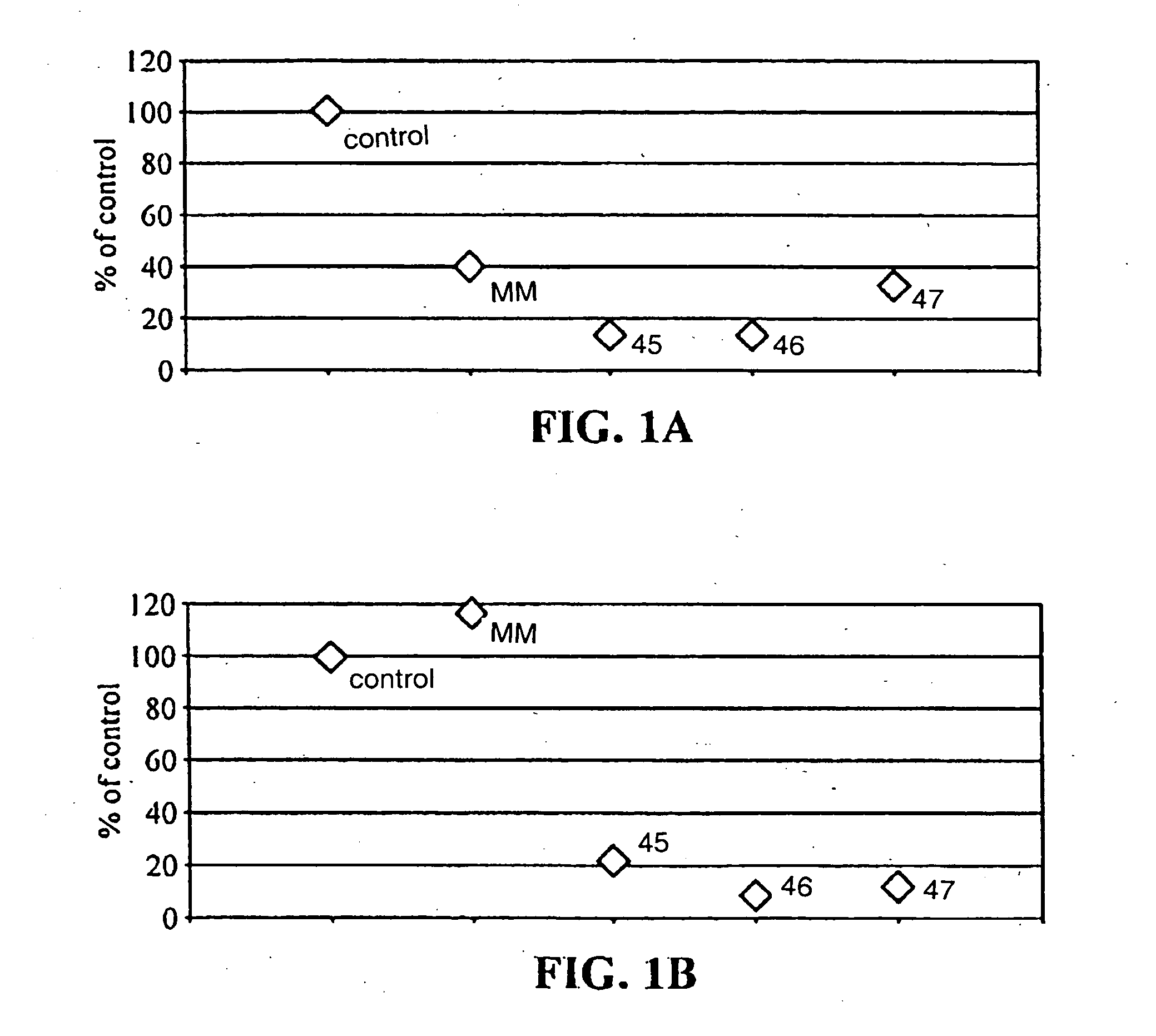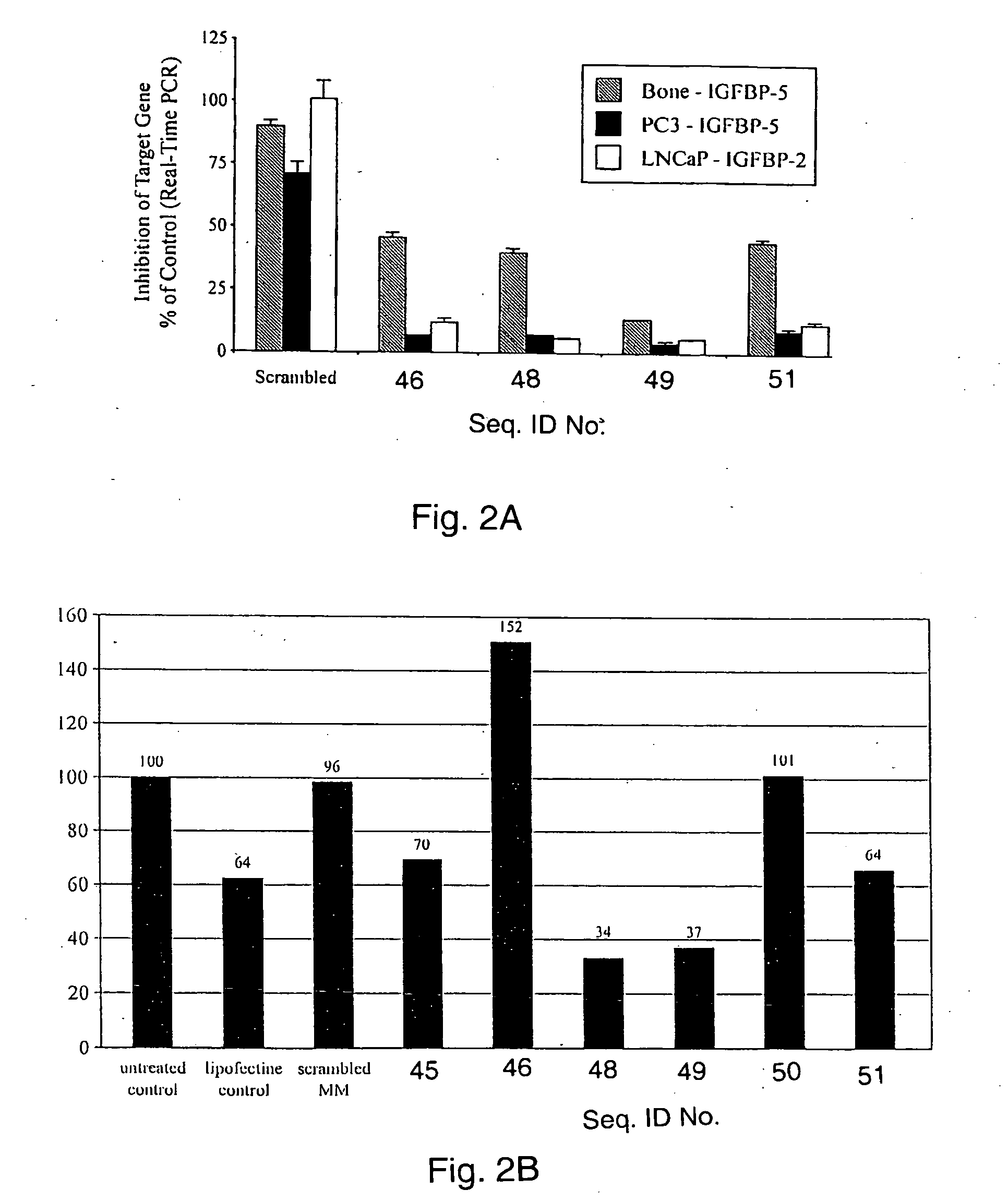Treatment of cancer by inhibition of IGFBP's and clusterin
a technology of igfbp and clusterin, which is applied in the direction of peptides, drug compositions, peptides, etc., can solve the problems of detracting from the efficacy of the therapeutic agent, and the second effect is not good, so as to stimulate the expression of clusterin, increase the expression of protein clusterin, and reduce the amount of igfbp-2
- Summary
- Abstract
- Description
- Claims
- Application Information
AI Technical Summary
Benefits of technology
Problems solved by technology
Method used
Image
Examples
example 1
[0062] LNCaP cells were treated with treated with 500 nM concentrations of antisense oligonucleotides of Seq. ID Nos. 45, 46 or 47 or a mismatch control. Levels of IGFBP-2 were measured. The results are summarized in FIG. 1A.
[0063] PC3 cells were treated with treated with 500 nM concentrations of antisense oligonucleotides of Seq. ID Nos. 45, 46 or 47 or a mismatch control. Levels of IGFBP-5 were measured. The results are summarized in FIG. 1B
example 2
[0064] Bispecific antisense oligonucleotides were used to treat PC3, LNCaP and bone cells at concentration of 500 nm, and the amount of inhibition of IGFBP-2 or IGFBP-5 was measured using real time PCR. Oligonucleotides of Seq. ID Nos. 46, 48, 49 and 51 were tested, and all were effective to reduce the detected amount of the IGFBP measured. (FIG. 2A) Reductions of up to 70% in IGFBP-2 levels were also observed in A549 lung cells using 500 nM of Seq. ID Nos. 48 and 49. (FIG. 2B) Seq. ID No. 48 (500 nM) was also shown to be effective to inhibit cell growth of LNCaP cells and reduce the cell number by more than 90%. (FIG. 2C) FIGS. 2D and E respectively show results for inhibition of IGFBP-5 levels in PC3 cells with 500 nM of Seq ID Nos. 45, 46, 48, 49, 50 and 51; and inhibition of IGBFP-5 levels in human fetal bone fobroblast cells with 500 nM of Seq. ID Nos. 45, 46, 48, 49, 50 and 51.
example 3
[0065] Real time PCR was used to measure the amount IGFBP-5 in MSF human fetal fibroblast cells after treatment with antisense oligonucleotide and LIPOFECTIN (4 μg / ml). Cells were plated in vitro and treated with a four-hour pulse of 500 nM oligonucleotide followd by a 20 hour period in normal medium plus 5% serum. A second four-hour pulse was repeated on day 2 and the cells were counted on day 3. The most active antisense oligonucleotides were Seq. ID Nos. 48 and 49. (FIG. 5)
PUM
| Property | Measurement | Unit |
|---|---|---|
| concentrations | aaaaa | aaaaa |
| stability | aaaaa | aaaaa |
| α | aaaaa | aaaaa |
Abstract
Description
Claims
Application Information
 Login to View More
Login to View More - R&D
- Intellectual Property
- Life Sciences
- Materials
- Tech Scout
- Unparalleled Data Quality
- Higher Quality Content
- 60% Fewer Hallucinations
Browse by: Latest US Patents, China's latest patents, Technical Efficacy Thesaurus, Application Domain, Technology Topic, Popular Technical Reports.
© 2025 PatSnap. All rights reserved.Legal|Privacy policy|Modern Slavery Act Transparency Statement|Sitemap|About US| Contact US: help@patsnap.com



